Preface: Why Every Driver Should Pay Attention to TPMS Sensor Batteries
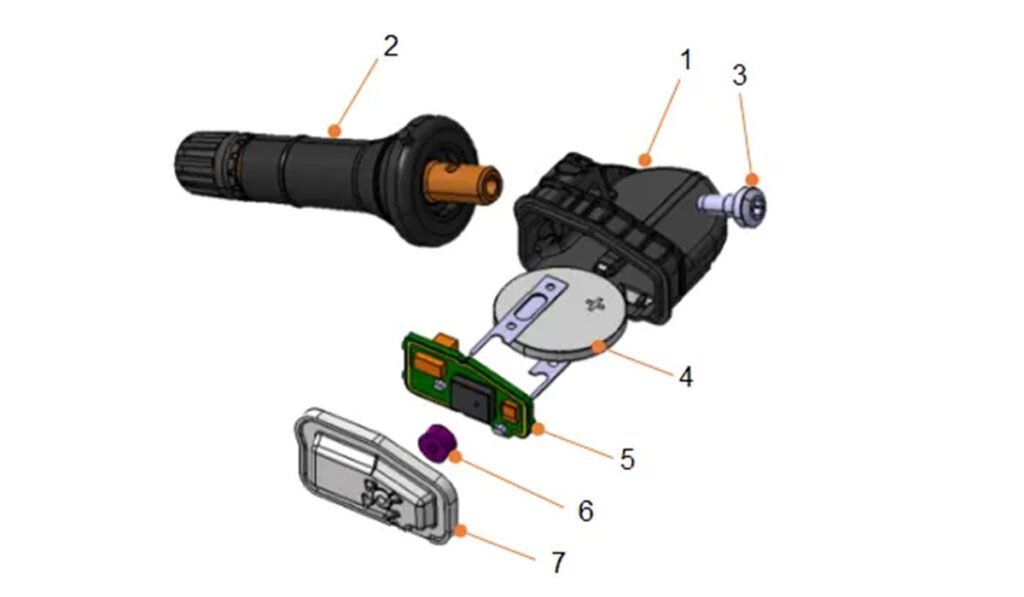
The Tire Pressure Monitoring System (TPMS) has become a mandatory safety feature worldwide. A direct TPMS is built into the tire sensor and relies on a tpms sensor battery to continuously power the system, transmitting real-time tire pressure and temperature data to the vehicle’s ECU.
Whether you are driving a Ford F-150 in North America, a VW Golf in Europe, a Toyota Corolla in Asia, a Honda BR-V in Southeast Asia, or a Ford Ranger in Australia, the lifespan of the tpms sensor battery is typically 3–7 years. Once the battery begins to fail, it not only triggers the dashboard warning light but can also cause data loss and significantly increase the risk of a tire blowout at high speeds.
This guide is based on the official maintenance manuals and service standards of leading automakers such as Ford, BMW, Toyota, and Honda, and it covers various environments across the globe:
- Middle East extreme heat (surface temperature exceeding 60℃, reducing battery life by up to 30%).
- Northern Europe severe cold (below −30℃, causing sudden voltage drops and false warnings).
- Southeast Asia humidity (where non-automotive batteries may leak and corrode easily).
At the same time, this guide will help you avoid the most common mistakes made by drivers worldwide:
- Using industrial-grade batteries — lifespan only 1–2 years, with high leakage risk.
- Choosing the wrong model — differences in diameter or thickness may directly damage the sensor.
📌 Key Reminder: There are two types of TPMS systems in the global market:
- Direct TPMS (with internal sensors, requiring a tpms sensor battery replacement) — accounts for over 80% of vehicles worldwide and is the main focus of this article.
- Indirect TPMS (using ABS wheel speed calculation, no battery required) — if the warning light comes on, check for a tire leak or ABS sensor issue.
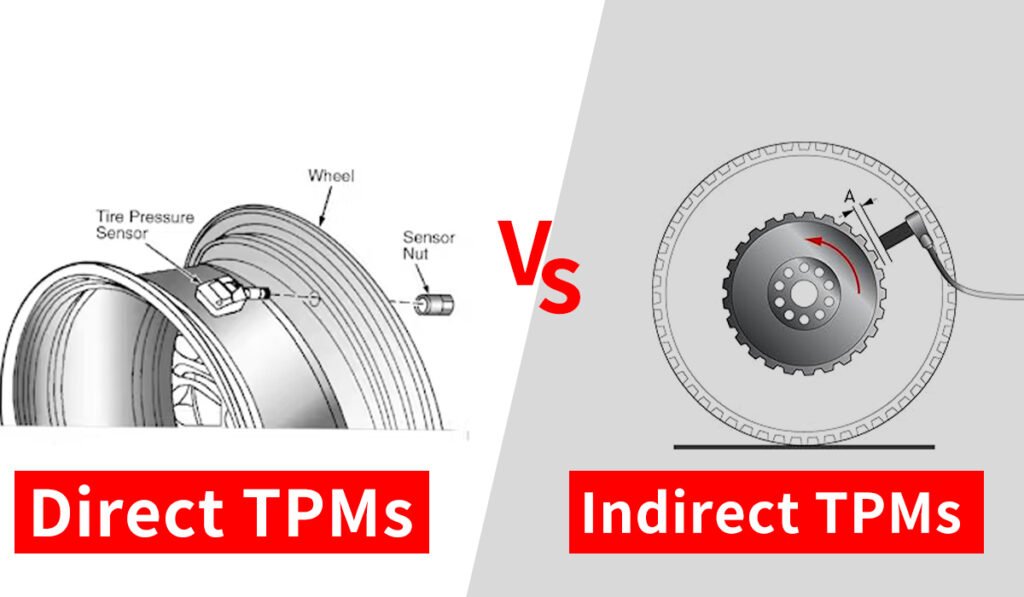
Global conditions have a direct impact on the performance of a tpms sensor battery. While IEC 60086-4 and SAE J2657 define the required temperature range (−40℃ to 125℃) and vibration standards, real-world battery life also depends on climate and driving habits — for example, extreme heat in the Middle East, freezing winters in Northern Europe, or high humidity in Southeast Asia.
👉 In this article, we will fully answer the most important global questions about tpms sensor battery replacement: how to determine battery life, how to avoid buying the wrong model, how to safely perform DIY replacement, and how costs compare across North America, Europe, and Asia.
Chapter 1. TPMS Sensor Battery Basics: Models, Lifespan & Global Fitment
A tpms sensor battery is a specially designed automotive-grade lithium coin cell for direct TPMS. Its key specifications — size, voltage, and high-temperature resistance — must exactly match the original battery. Different models are not interchangeable.
For example: CR2450HR cannot replace CR2032HR — the size difference will immediately damage the TPMS sensor.
Global Mainstream Automotive TPMS Battery Models
(Based on official OEM recommendations, including regional and less common vehicles for global reference)
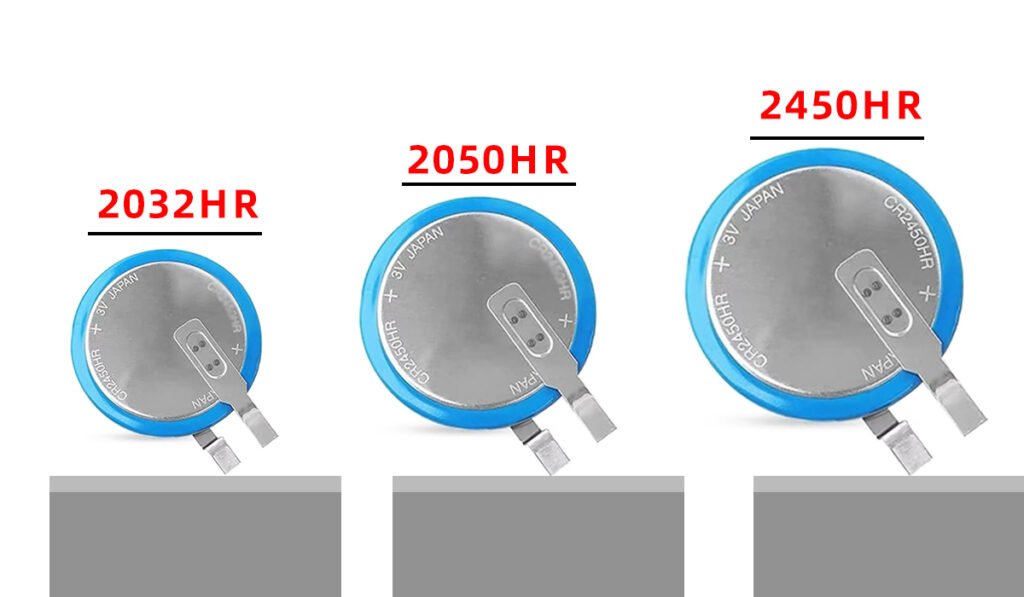
| Battery Model | Size (Metric / Imperial) | Typical Capacity | Avg. Lifespan | Example Vehicles (OEM Guidance) |
|---|---|---|---|---|
| CR2032HR | 20×3.2mm (0.79×0.126in) | ≈220mAh | 3–5 years | North America: Ford F-150 (officially 5 yrs / 100k km), Chevy Silverado; Europe: VW Golf (manual 4–6 yrs), Audi A3; Asia: Toyota Corolla (5 yrs at dealership), Honda Civic; Southeast Asia: Honda BR-V, Toyota Innova; Australia: Ford Ranger, Holden Colorado; South America: Chevy Onix, VW T-Cross |
| CR2050HR | 20×5.0mm (0.79×0.197in) | ≈350mAh | 4–6 years | North America: GMC Sierra; Europe: BMW X1 (“check voltage after 6 yrs” in manual); Asia: Hyundai Tucson, Kia K5; Australia: Mitsubishi Triton |
| CR2450HR | 24.5×5.0mm (0.96×0.197in) | ≈600mAh | 5–7 years | North America: Tesla Model 3 (manual suggests 7 yrs); Europe: Mercedes C-Class, Porsche Macan; Asia: Lexus ES (officially 6 yrs), Nissan Teana; Southeast Asia: Mitsubishi Xpander, Nissan Almera; South America: Fiat Toro, Peugeot 2008 |
| CR2025HR | 20×2.5mm (0.79×0.098in) | ≈170mAh | 2–4 years | Europe: Peugeot 308 (manual 3–4 yrs), Citroën C4; Asia: Kia Sportage, Mazda CX-5; Australia: Holden Trax |
| CR2477HR | 24×7.7mm (0.94×0.303in) | ≈900mAh | 6–8 years | North America: Ford F-250, Chevy Silverado HD; Australia: Toyota Tacoma (OEM guide: 6 yrs, off-road use) |
Global Environmental Factors Affecting Lifespan

According to SAE J2657 and IEC 60086-4 standards, environmental conditions have a direct impact on tpms sensor battery performance:
- High temperatures (Middle East, North American summer roads 60℃+): lifespan reduced by 20–30%, swelling risk increases.
- Extreme cold (Northern Europe, Canadian winters below −30℃): voltage drops faster, often causing false alerts.
- High humidity (Southeast Asia rainy season): if the TPMS housing seal is weak, corrosion risk increases → replacement every 4 years recommended.
- Driving conditions: frequent off-road / high-speed use accelerates aging by ~15% (e.g., Jeep Wrangler officially recommends 4 years).
TPMS Communication Frequency Check (Avoid Scanner Mistakes)
Globally, TPMS sensors operate on two common frequencies. Before purchasing a scanner, confirm which frequency your vehicle uses:
- North America: mostly 315MHz (e.g., Ford, Chevy, Tesla).
- Europe / Asia / Southeast Asia / Australia / South America: mostly 433MHz (e.g., BMW, Toyota, Honda).
How to confirm frequency:
- Check the vehicle manual → e.g., Ford F-150 manual, page 127: “315MHz.”
- Use an OBD diagnostic tool → e.g., Autel MaxiTPMS showing “Frequency: 433MHz.”
- Inspect sensor housing engraving → some sensors directly mark “315” or “433.”
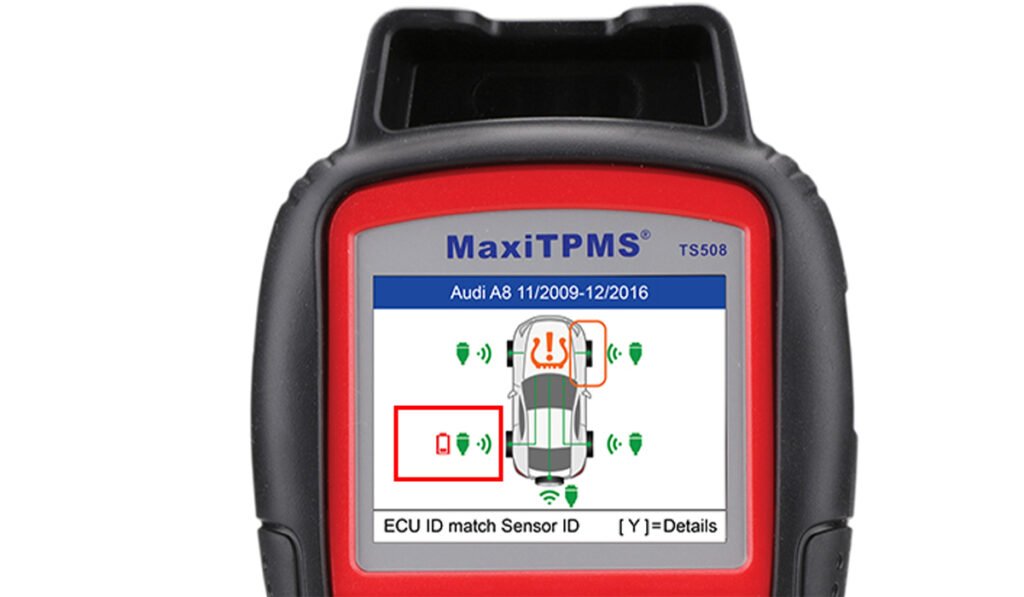
Chapter 2. Four Universal Signs That a TPMS Sensor Battery Needs Replacement
No matter which country or region you are in, when the tpms sensor battery begins to lose power, your vehicle will show the following four universal warning signals. While the exact wording on the dashboard may differ between regions, the core logic is always the same:
1. TPMS Warning Light Stays On
- After starting the car, the warning light remains illuminated for 3–5 minutes, even when the tires are inflated to the recommended pressure shown on the door label:
- Sedans: 2.2–2.5 bar (32–36 PSI)
- Pickup trucks: 2.4–2.8 bar (35–41 PSI)
- Regional differences in messages:
- North America: “TPMS Light On”
- Europe: “TPMS Fault”
- Asia / Southeast Asia: “TPMS System Error”
- Australia: “Tire Pressure Monitor Error”
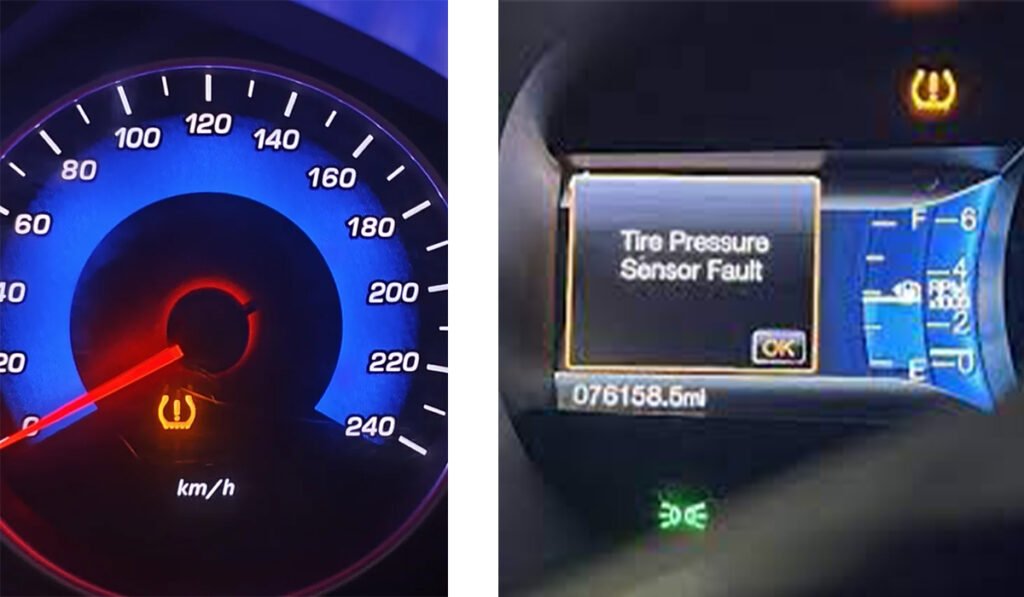
2. Loss or Flashing of Tire Pressure Data
- The dashboard shows “— —” or “No Data” for one or more tires.
- More common in cold weather (≤−10℃ / 14℉) or in humid climates (e.g., Southeast Asia rainy season), as low temperature and high humidity reduce battery activity and cause temporary voltage drops.
3. Diagnostic Tool Indicates Low Voltage
- Using a TPMS scanner (e.g., Autel MaxiTPMS, Launch X431), the system clearly shows:
- “Battery Voltage Low” or “Sensor Battery Critical.”
- When voltage drops below 2.7V, the international SAE J2657 standard defines this as the low-power threshold, meaning the tpms sensor battery should be replaced.
4. Sensor Has Been in Use for Over 5 Years
- Even if the warning light has not come on, if the TPMS sensor battery has been in use for more than 5 years, replacement is strongly recommended.
- Manufacturer guidance:
- Ford & Toyota manuals: recommend preventive replacement at 5 years or 100,000 km.
- Southeast Asia / high-humidity regions: replacement is recommended every 4 years to avoid sudden failures on the road.
Chapter 3. Why You Must Choose an Automotive-Grade TPMS Sensor Battery
One of the most common mistakes among drivers worldwide is trying to save money by using a standard coin cell instead of a tpms sensor battery. For example, some drivers install a regular CR2032 used in remote controls or scales rather than the required automotive-grade version. This choice almost always causes problems:
- Leakage or swelling within just 1–2 years.
- Poor heat resistance, leading to rapid failure in hot or humid climates.
- In severe cases, the TPMS unit itself is destroyed — replacement costs range from $100–200 (¥500–1500) per sensor.
⚠ Reminder: Automakers such as BMW, Ford, and Toyota explicitly warn in their service manuals that using a non-automotive tpms sensor battery will void warranty coverage.
Automotive-Grade vs Industrial Battery: Key Differences
The following table compares an automotive-grade tpms sensor battery with a standard industrial coin cell, based on IEC 60086-4 and SAE J2657 standards:
| Dimension | Automotive-Grade tpms sensor battery (e.g., CR2032HR) | Industrial Battery (e.g., standard CR2032) |
|---|---|---|
| Operating Temp. Range | −40℃ to 125℃ (suitable for extreme heat, cold, and humidity in tires) | 0℃ to 60℃ (indoor electronics only) |
| Vibration Resistance | SAE J2657 compliant (withstanding long-term driving vibration, amplitude ≤20g) | No vibration design (easily loose or faulty contact) |
| Stability & Lifespan | 3–7 years in TPMS conditions, ≤10% annual voltage drop | 1–2 years only, leakage risk in heat/humidity, ≥30% annual decay |
| Certification | IEC 60086-4 automotive safety standard | Consumer electronics only |
| Safety Design | Built-in anti-leak seal ring (IP67, moisture/dust protection) | No sealing, high risk of leakage and corrosion |

Quick Global Guide: How to Identify the Right TPMS Sensor Battery
- Check the Model Suffix
- Always choose a model ending with “HR” (e.g., CR2032HR).
- “HR” means High Reliability / High Temperature Resistance, the hallmark of an authentic tpms sensor battery.
- Heavy-duty vehicles often use larger-capacity models such as CR2477HR.
- Inspect the Engraving
- Genuine automotive batteries: model engraved on the metal rim.
- Industrial versions: printed on the flat surface, which easily wears off.
- Select Trusted Brands
- Recommended manufacturers:
- Panasonic (Tesla, Toyota OEM)
- Maxell (BMW, Audi OEM)
- Energizer (Ford, GM OEM)
- Varta (VW, Mercedes, Peugeot OEM)
- Avoid unbranded cells — most are industrial-grade batteries disguised as tpms sensor battery alternatives.
- Recommended manufacturers:
Chapter 4. Global Tool Checklist: Essentials for DIY TPMS Sensor Battery Replacement
No matter where you are in the world, replacing a tpms sensor battery only requires a few essential tools and materials. All of them are easily available on local platforms, and every recommendation here follows official OEM repair standards to ensure both safety and precision.
Tools & Materials Checklist
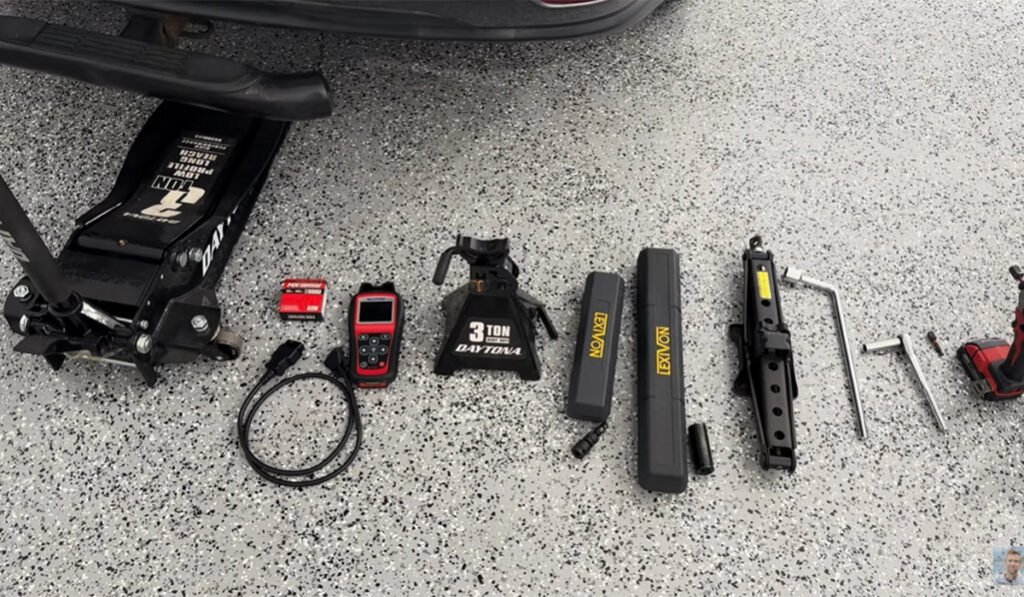
| Tool / Material | Main Purpose | International Brand Recommendations (Regional Adaptation) | OEM Standard Requirements (Beginner Notes) | Local Platform Search Keywords (Examples) |
|---|---|---|---|---|
| Automotive-Grade tpms sensor battery | Core component | Panasonic (Global), Maxell (Europe/Asia), Energizer (North America), Varta (Europe) | Must exactly match the old model (Ford/BMW manuals clearly state: wrong model = sensor damage) | NA: Amazon “CR2032HR TPMS battery Energizer”; EU: Amazon.de “CR2032HR Maxell Auto”; Asia: JD Global “Panasonic CR2032HR automotive”; SEA: Lazada “CR2032HR Panasonic TPMS” |
| Jack + Lug Wrench | Lift car & remove wheels | Bosch (Global), SATA (Asia), Craftsman (NA), Kincrome (AU) | Jack capacity ≥2 tons; torque precision ±5%; NA must comply with ANSI/ASME PALD; EU tools must carry CE mark | NA: Home Depot “Craftsman 2-ton jack”; EU: Bauhaus “Bosch Auto Jack CE”; AU: Bunnings “Kincrome Wheel Wrench” |
| Torx Screwdriver (T10/T15) | Open TPMS housing & secure screws | Wiha (EU), Stanley (NA), Deli (Asia), Sidchrome (AU) | Tip hardness ≥HRC55 (BMW specifies to avoid stripping sensor screws) | NA: Amazon “Stanley Torx T10 T15 Set”; EU: Amazon.co.uk “Wiha Torx Screwdriver T10”; Asia: Taobao “Deli T10 T15 Torx Screwdriver” |
| Plastic Pry Tool | Damage-free opening of housing | 3M (Global), Apollo Tools (NA), Lulin (Asia), Repco (AU) | Must be nylon (Ford standard; metal prying tools can scratch housing → water ingress) | NA: AutoZone “3M Plastic Pry Tool”; EU: Euro Car Parts “Apollo Plastic Trim Tools”; Asia: Pinduoduo “Nylon pry bar automotive” |
| Digital Tire Gauge | Verify tire pressure after replacement | Michelin (Global), Goodyear (NA), Steel Mate (Asia), Ryco (AU) | Accuracy ±0.1bar (±1.5 PSI); must comply with SAE J1205 standard | NA: Walmart “Goodyear Digital Tire Gauge”; EU: Tesco “Michelin Digital Tyre Pressure Gauge”; Asia: JD “Steel Mate Digital Gauge” |
| Anti-Static Gloves | Protect sensor electronics | Ansell (Global), Kimberly-Clark (NA), Bluesail (Asia), SafeWork (AU) | Resistance ≤10^9Ω (Toyota requires to avoid sweat/static damage) | NA: Amazon “Ansell ESD Gloves”; EU: Amazon.fr “Kimberly-Clark Anti-Static Gloves”; Asia: Tmall “Bluesail ESD Repair Gloves” |
| TPMS Scanner (Optional) | Force reset / relearn | Autel MaxiTPMS (NA/Asia), Launch X431 (EU), OTC (NA Pro), Autel Australia (AU) | Must support your vehicle protocol + correct frequency (NA = 315MHz, EU = 433MHz) | NA: Amazon “Autel MaxiTPMS TS601 315MHz”; EU: Amazon.de “Launch X431 TPMS Tool 433MHz”; Asia: Tmall “Autel MaxiTPMS Toyota” |
Safety Reminders (Global Compliance)
- North America: Jacks must comply with ANSI/ASME PALD. Never use uncertified cheap jacks (per NHTSA guidelines).
- Europe: All tools must have CE certification (e.g., Torx screwdrivers, digital gauges), otherwise accuracy may be compromised.
- Southeast Asia & Australia: After working in humid conditions, wipe the TPMS housing dry to prevent corrosion.
- Universal: Always work on flat, solid ground (garage or parking lot). Apply the parking brake, put the car in P gear (manual = 1st gear), and use wheel chocks. Lift the car only at OEM-approved jacking points (e.g., Ford F-150 door sill notch, BMW 3 Series reinforced rail).
Chapter 5. Five-Step Replacement Process: OEM Standard Procedure (Ford / BMW / Toyota / Regional Models)
The following process follows official manuals from Ford, BMW, Toyota, and Honda, covering over 90% of direct TPMS systems. From North American pickups to European sedans and Southeast Asian SUVs, this guide ensures that even beginners can successfully complete a tpms sensor battery replacement.
Step 1: Safely Jack the Car & Remove the Wheel

- Use a lug wrench to slightly loosen the wheel nuts by a quarter turn (do not fully remove them yet).
- Refer to your OEM manual for the correct jacking points:
- Ford F-150: under-door notch.
- BMW 3 Series: reinforced chassis rail.
- Honda BR-V: inner side skirt.
- Ford Ranger: rear frame reinforcement.
- Jack up until the wheel clears the ground by about 5 cm (2 in).
- Remove the nuts fully, place them carefully, and remove the wheel.
Step 2: Locate and Remove the TPMS Sensor
- Locate the TPMS sensor on the inner side of the wheel. Common designs include:
- Valve-integrated type (Toyota Corolla, Honda BR-V, VW Golf).
- Bolt-mounted type (BMW 3 Series, Ford F-150, Ranger).
- Removal:
- Bolt-mounted: unscrew gently with Torx T10/T15 (≈ 2 N·m).
- Clip-mounted: use nylon pry tool, avoid pulling the wires.
- Place the removed sensor on a clean cloth and dry if in humid climates.
Step 3: Open the Housing & Replace the Battery
- Use a pry tool to open the housing (Ford: 3 clips, Toyota: 2, Honda BR-V: 4).
- Remove the old tpms sensor battery, and take a photo of the polarity before replacement.
- Clean the housing with a dry cloth (or alcohol swab if leakage is found).
- Insert the new tpms sensor battery (e.g., CR2032HR), align polarity, press until it clicks.
- Close the housing securely to prevent water or dust intrusion.
⚠ Warning: Do not bend the inner contacts. Damaging them will destroy the sensor and lead to costly replacements.
Step 4: Reinstall the Sensor & Wheel
- Reinstall the sensor:
- Valve-integrated: torque ≈ 5 N·m.
- Bolt-mounted: torque ≈ 3 N·m.
- Refit the wheel, tighten nuts by hand, lower the car, then torque in a star pattern:
- Sedans: 108–120 N·m.
- Pickups: 120–150 N·m.
- Following the manual ensures the new tpms sensor battery operates reliably under proper installation conditions.
Step 5: Reset and Test the TPMS System
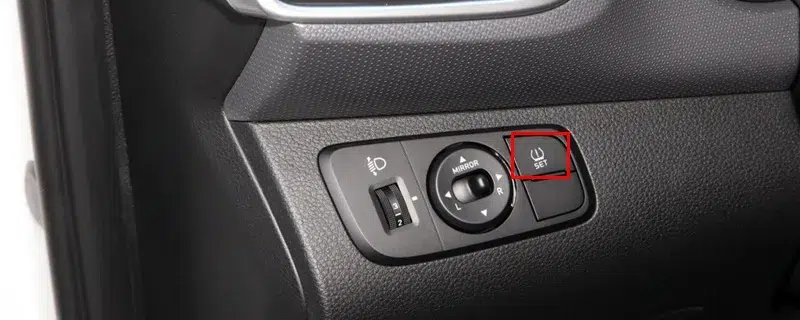
- Drive 5–10 km; most vehicles relearn automatically.
- If not, reset manually:
- Ford F-150: Steering wheel OK → “TPMS Reset.”
- BMW 3 Series: Infotainment → Vehicle Settings → Reset.
- Toyota Corolla: Press TPMS button for 5 seconds.
- Honda Civic/BR-V: Settings → Tire Pressure Monitoring → Calibrate.
- If unsuccessful, use a TPMS scanner for forced relearn.
- Confirm pressure with a digital gauge:
- Sedans: 2.2–2.5 bar.
- SUVs/Pickups: 2.4–2.8 bar.
If the TPMS light does not reset automatically, follow the OEM procedure or use a TPMS scan tool.
👉 For detailed instructions on different reset methods, see our full guide: How to Reset Tire Pressure Correctly.
OEM Special Notes
- Tesla Model 3/Y: Requires reset through car menu and ≥10 km of driving for relearn.
- Southeast Asian vehicles: If the TPMS light remains on after replacement, check housing seals. Use adhesive if necessary to protect the new tpms sensor battery from moisture.
👉 If your vehicle uses a sealed or non-serviceable TPMS unit, you can purchase high-quality replacements directly from our TPMS Sensor Wholesale Page.
Chapter 6. Global Cost Comparison: DIY vs Professional Service (2025 Latest Pricing + Assembly Reference)
The cost of replacing a tpms sensor battery varies significantly across regions. In most cases, DIY replacement saves more than 60% compared to professional service. However, for sealed sensors, lack of tools, or repeated reset failures, professional assistance is strongly recommended. Below is the updated global cost reference for 2025.
Global Cost Comparison Table (2025 Edition)
| Region | DIY Cost (Battery + Tools) | Independent Shop | Authorized Dealership | Sensor Assembly Price (Sealed Models) | Labor Time |
|---|---|---|---|---|---|
| North America (US / Canada) | $15–40 (Battery $5–15 + Tools $10–25) | $30–80 per sensor (incl. labor + automotive battery) | $100–200 per sensor (OEM parts) | $80–150 each (Ford / GM / Tesla) | 30–45 min |
| Europe (Germany / UK / France) | €10–30 (Battery €3–10 + Tools €7–20) | €25–70 per sensor | €80–180 per sensor (OEM) | €70–130 each (BMW / VW / Mercedes) | 40–60 min |
| Asia (China / Japan / Korea) | ¥100–300 (Battery ¥10–30 + Tools ¥90–270) | ¥200–600 per sensor | ¥500–1500 per sensor (OEM) | ¥300–800 each (Toyota / Honda / BYD) | 20–40 min |
| Southeast Asia (Indonesia / Thailand) | 50,000–150,000 IDR (Battery 10k–30k + Tools 40k–120k) | 100k–300k IDR per sensor | 300k–800k IDR per sensor (OEM) | 200k–500k IDR each (Honda / Toyota / Mitsubishi) | 30–50 min |
| Australia | A$20–50 (Battery A$5–15 + Tools A$15–35) | A$40–100 per sensor | A$120–250 per sensor (OEM) | A$100–200 each (Ford / Holden / Mitsubishi) | 35–50 min |
| South America (Brazil / Argentina) | R$50–150 (Battery R$15–45 + Tools R$35–105) | R$100–300 per sensor | R$300–800 per sensor (OEM) | R$200–500 each (Chevy / Ford / Fiat) | 40–60 min |
When You Must Choose Professional Service (OEM Guidance)
- Sealed Non-Replaceable Sensors
- Vehicles: Tesla Model Y 2024, BMW iX3, BYD Seal.
- These cannot be opened. DIY attempts may damage the unit.
- BMW manual states: “Sealed sensors only support full assembly replacement.”
- Lack of Tools or Unsafe Environment
- No jack, torque wrench, or working on unsafe surfaces (roadside, slopes).
- Ford official warning: “Do not attempt tire/sensor replacement on uneven ground due to rollover risk.”
- In Southeast Asia’s rainy season, wet surfaces increase the risk of short circuits.
- Repeated Reset Failures
- Requires professional diagnostic tools:
- Toyota: GTS scanner to test frequency.
- Honda: HDS tool to read fault codes.
- BMW: ISTA tool to confirm offline sensor.
- Requires professional diagnostic tools:
Core Takeaways
- DIY is cheapest: In most regions, the tpms sensor battery plus tools cost only local currency equivalent of 15–50, making it suitable for experienced drivers.
- Independent shops are flexible: For drivers without tools, costs are 2–3x DIY but still cheaper than dealerships.
- Authorized dealerships are the most expensive but reliable: Best choice for beginners or premium cars, especially under warranty to ensure genuine parts.
Global Car Owners FAQ (Including CR2032HR vs CR2450HR Comparison + Special Cases)
Q1: Can a standard CR2032 replace a CR2032HR as a tpms sensor battery?
A1: Absolutely not recommended. Standard CR2032 cells are industrial-grade, with poor durability under heat or humidity, while CR2032HR is an automotive-grade tpms sensor battery designed for −40℃ to 125℃ and long-term stability. Both Ford and BMW warn that using a non-automotive battery will void warranty and may permanently damage the TPMS sensor. ⚠ Drivers in Southeast Asia should be especially cautious due to high humidity accelerating corrosion.
Q2: CR2032HR vs CR2450HR vs CR2477HR – which is the right tpms sensor battery?
A2: The correct choice always depends on your vehicle’s original specification, not on capacity alone.
- CR2032HR is standard for compact cars such as Toyota Corolla and Honda BR-V.
- CR2450HR is required for mid-size and premium vehicles such as Tesla Model 3 and Lexus ES.
- CR2477HR is designed for heavy-duty pickups like the Ford F-250 or Toyota Tacoma, where higher capacity is essential.
✅ Summary: Always match the tpms sensor battery model exactly as specified by your vehicle manufacturer to avoid fitment or reliability issues.
Q3: What if the tire pressure warning light stays on after replacement?
A3: First, confirm the battery polarity and make sure the housing is fully sealed. In humid regions such as Southeast Asia, also check for water inside the sensor and clean if needed.
Most vehicles will automatically reset after a short drive of 5–10 km. If the warning light remains on, use a TPMS scanner compatible with your region’s frequency (315MHz in North America, 433MHz in Europe/Asia).
If no signal is detected even with a scanner, the tpms sensor battery or the entire sensor unit may have failed and should be replaced.
Q4: Are EV and gasoline vehicles the same when replacing a tpms sensor battery?
A4: It depends on the type of TPMS sensor installed.
- Traditional coin cell type (BYD Han, Tesla Model 3 pre-2023, Mitsubishi i-MiEV): Replacement is the same as gasoline cars, simply use the correct CR2450HR or CR2032HR.
- Sealed BLE Bluetooth type (Tesla Model Y 2024+, BYD Seal, BMW iX3): The module is sealed, so the tpms sensor battery cannot be replaced individually. The entire sensor assembly must be replaced.
- Reference: Tesla 2025 service manual, BYD official repair guide.
Q5: How to extend the lifespan of a tpms sensor battery in different climates?
A5: Automakers such as Ford, BMW, and Honda recommend adapting maintenance to your local environment:
- Hot climates (Middle East, North America): Park in shade/garages and check tire pressure monthly.
- Cold climates (Northern Europe, Canada): Replace before winter to avoid voltage drops; frequent warnings in freezing weather mean the battery is weakening.
- Humid climates (Southeast Asia): Apply extra sealing when replacing; change every 4 years instead of 5.
- Universal tips: Drive the vehicle at least once a month, avoid prying damage during tire service, and always choose genuine automotive-grade batteries (Panasonic, Maxell, Energizer, Varta).
Conclusion: 3 Golden Rules for tpms sensor battery Replacement
- Always match the exact model
Confirm the old battery model (e.g., CR2032HR, CR2450HR, CR2477HR) before replacing.
Do not switch models just for “higher capacity.”
⚠ Heavy-duty pickups (e.g., Ford F-250, Toyota Tacoma) must exclusively use CR2477HR. - Choose only automotive-grade HR batteries
Look for the HR suffix, engraved edge markings, and trusted brands such as Panasonic, Maxell, Energizer, and Varta.
These automotive-grade cells comply with IEC 60086-4 and provide 3–7 years of reliable lifespan, even in harsh climates. - Follow OEM service standards
Use correct jacking points and torque settings, and perform a proper reset using OEM instructions or a TPMS scanner.
⚠ In humid regions like Southeast Asia, add extra sealing to protect the tpms sensor battery from moisture damage.
